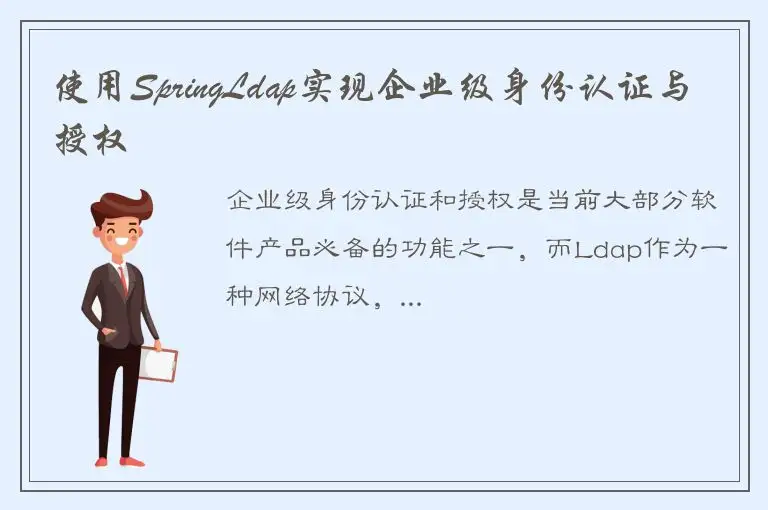企业级身份认证和授权是当前大部分软件产品必备的功能之一,而Ldap作为一种网络协议,也是企业级认证和授权的首选方案之一。而SpringLdap则是一个在Java语言中应用Ldap协议的框架。接下来我们将详细介绍使用SpringLdap实现企业级身份认证和授权的方案以及相关代码。

一、Ldap简介
首先我们需要了解Ldap和关于Ldap的一些基本概念和术语。
Ldap是Lightweight Directory Access Protocol(轻量级目录访问协议)的简称,是一种在TCP/IP协议上的应用层协议。它提供了一种统一的方法来访问分布式的目录服务。该协议主要用于访问由X.500标准定义的分布式目录服务。
Ldap中的最基本的目录对象是entry,一个entry由一组属性(attribute)组成。每个属性由一个名称和一个或多个值组成。例如,entry的“姓名”属性可能有多个值,每个值表示该entry的一个不同名称。属性可以是单值的,也可以是多值的。entry可以包含子entry,形成树形结构。
Ldap目录树(directory tree)是由具有父子关系的Ldap entry组成的分层体系结构。Ldap的目录树是有标准命名规则的,即Distinguished Name(DN)。DN是唯一的且不可更改的,它由多个client DN(数据库名称)组合而成,以逆序排列,各个client DN之间由“,”隔开。例如,“cn=John Doe, ou=People, dc=example, dc=com”就是一个DN。
二、SpringLdap简介
Spring Framework是一个Java平台的开源应用框架。SpringLDAP是Spring Framework中用于集成Ldap的模块。SpringLDAP通过封装JndiTemplate和LdapTemplate模板类,提供了一个简单而强大的框架,用于与Ldap目录服务器通信。
SpringLdap中最常用的两个类是LdapTemplate和LdapContextSource。LdapContextSource类封装了与Ldap服务器的连接和绑定,LdapTemplate类是Ldap访问的主要类,提供了一系列的Ldap操作方法。
三、SpringLdap认证实现
实现用户认证的步骤通常包括以下几个步骤:
1. 与Ldap服务器建立连接。
2. 使用查询语句查询指定用户的DN。
3. 使用查询到的DN和用户提供的密码进行登录尝试。
4. 如果登录成功,返回认证通过的信息。
下面是一个简单的SpringLdap实现用户认证的代码:
```
public class LdapAuthenticator implements UserDetailsService {
private LdapTemplate ldapTemplate;
public LdapAuthenticator(LdapTemplate ldapTemplate) {
this.ldapTemplate = ldapTemplate;
}
@Override
public UserDetails loadUserByUsername(String username) throws UsernameNotFoundException {
String dn = getUserDn(username);
DirContextOperations user = ldapTemplate.lookupContext(dn);
return new User(username, "", AuthorityUtils.createAuthorityList("ROLE_USER"));
}
private String getUserDn(String username) {
List
LdapQueryBuilder.query().where("objectclass").is("person").and("sAMAccountName").is(username),
(AttributesMapper
if(result.isEmpty()){
throw new UsernameNotFoundException("User not found");
}
return result.get(0);
}
public boolean authenticate(String username, String password){
return ldapTemplate.authenticate("", "(sAMAccountName="+username+")", password);
}
}
```
在这个例子中,我们使用了一个简单的UserDetailsService来查询用户信息。在查询用户信息时,我们首先需要获得该用户的DN。在getUserDn(String username)方法中,我们使用了LdapQueryBuilder和AttributesMapper两个类来构造一个查询,以获得满足条件的用户DN。在查询中,我们使用了objectclass和sAMAccountName两个属性过滤器,以便找出LDAP服务器上具有指定名称的用户。查询出DN之后,我们就可以通过ldapTemplate.lookupContext(String dn)方法来获取DirContextOperations实例,并返回一个用于认证的UserDetails实例。
在最后一个authenticate(String username, String password)方法中,我们通过ldapTemplate.authenticate()方法来验证用户身份。authentication()方法接受三个参数:base(基础的搜索DN,在这里为空字符串),filter(过滤条件,在这里使用“sAMAccountName=username”的格式),以及password(用户的密码)。
当密码与LDAP服务器上的密码一致时,authenticate()方法返回true;如果验证失败,它将抛出一个LdapAuthenticationException异常。
四、SpringLdap授权实现
在SpringLdap中实现授权通常包括以下几步:
1. 为LDAP用户提供正确的角色。
2. 对方法或请求进行授权检查。
3. 添加必要的安全检查,并向运行时环境集成Spring Security框架。
下面我们使用SpringLdap实现一个授权的例子:
```
@Configuration
@EnableWebSecurity
public class WebSecurityConfig extends WebSecurityConfigurerAdapter {
@Autowired
LdapUserDetailsMapper ldapUserDetailsMapper;
@Override
public void configure(AuthenticationManagerBuilder auth) throws Exception {
auth.authenticationProvider(ldapAuthenticationProvider());
}
@Override
protected void configure(HttpSecurity http) throws Exception {
http.authorizeRequests()
.antMatchers("/admin/**").hasRole("ADMIN")
.anyRequest().authenticated()
.and()
.formLogin()
.loginPage("/login")
.permitAll()
.and()
.logout()
.permitAll();
}
@Bean
public AuthenticationProvider ldapAuthenticationProvider(){
LdapAuthenticationProvider ldapAuthenticationProvider = new LdapAuthenticationProvider(
bindAuthenticator(),
ldapAuthoritiesPopulator());
ldapAuthenticationProvider.setUserDetailsContextMapper(ldapUserDetailsMapper);
return ldapAuthenticationProvider;
}
@Bean
public LdapAuthoritiesPopulator ldapAuthoritiesPopulator(){
return new DefaultLdapAuthoritiesPopulator(ldapContextSource(),
"ou=groups,dc=springframework,dc=org");
}
@Bean
public BindAuthenticator bindAuthenticator(){
BindAuthenticator bindAuthenticator = new BindAuthenticator(ldapContextSource());
bindAuthenticator.setUserDnPatterns(new String[]{"uid={0},ou=people"});
return bindAuthenticator;
}
@Bean
public LdapContextSource ldapContextSource(){
LdapContextSource ldapContextSource = new LdapContextSource();
ldapContextSource.setUrl("ldap://localhost:389");
ldapContextSource.setBase("dc=springframework,dc=org");
ldapContextSource.setUserDn("cn=manager,dc=springframework,dc=org");
ldapContextSource.setPassword("password");
ldapContextSource.afterPropertiesSet();
return ldapContextSource;
}
}
```
在这个例子中,我们使用了@EnableWebSecurity注解在Spring Boot中启用Spring Security,通过重载configure(AuthenticationManagerBuilder auth)方法来配置身份验证(Authentication)的方式,通过重载configure(HttpSecurity http)方法来定义授权(注意这里只是定义了页面的访问权限,具体请求的访问权限需要自己根据自己的需求进行设置)。
下面我们来看ldapAuthenticationProvider()、ldapAuthoritiesPopulator()、bindAuthenticator()和ldapContextSource()这些Bean的配置。
ldapAuthenticationProvider()方法是使用LdapAuthenticationProvider实例,我们在这里指定了BindAuthenticator和DefaultLdapAuthoritiesPopulator。
ldapAuthoritiesPopulator()是使用Spring Security所提供的LdapAuthoritiesPopulator实例初始化。
bindAuthenticator(),这个类可以用来指定人员DN模板,并提供LDAP连接属性的说明,从而可以连接LDAP服务器并查找人员。在这个例子中,我们仅使用uid={0},ou=people查找人员。
ldapContextSource()创建一个LdapContextSource Bean,用来描述LDAP服务器。传入的setBase()方法设置了LDAP搜索的基础树的名称以及用户信息。
最后,我们通过注入LdapUserDetailsMapper类,实现将LDAP用户映射到自定义的UserDetails类型。
五、总结
本文介绍了SpringLdap如何实现企业级身份认证和授权。在该过程中,我们使用了SpringLdap框架来与LDAP服务器进行通信,并使用基于用户名和密码的身份验证和简单的角色授权方案来保护资源。随着企业级应用程序越来越多地涉及到分布式应用程序、微服务和多租户环境,使用SpringLdap是至关重要的,它可以提供更好的安全性和可靠性。




 QQ客服专员
QQ客服专员 电话客服专员
电话客服专员